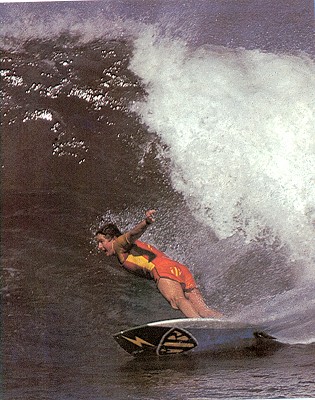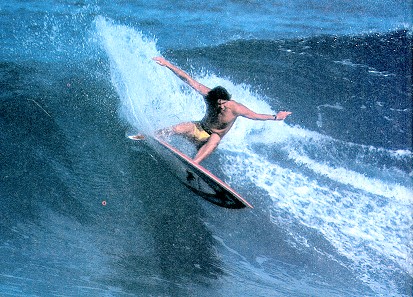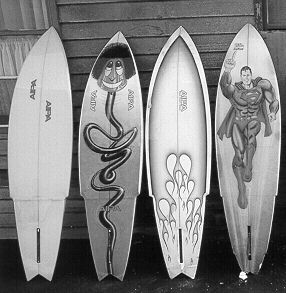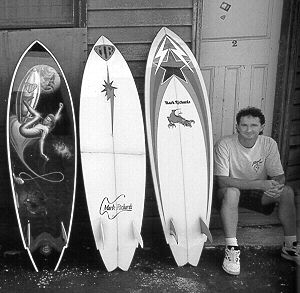 |
surfresearch.com.au
MR :
twin fins, 1978
|
mark richards : get the real thing

| home | catalogue | history | references | appendix |
 |
surfresearch.com.au
MR :
twin fins, 1978
|

| MY
ENCOUNTERS began
with the first appearance of the twin fin (Circa
1970).
As we all know, the early ones were very short, stubby and thick, especially in the tail, with fins foiled both sides. (See image and link, right). I surfed them through the changes four to five years, my last one being a 6'8" swallow tail. Somewhere around that time, the progression was lost. They seemed to have reached a limit where no one was capable of taking it any further. |
 |
Mark Richards' first Twin fin
II,
based on Reno Abelira's Fish, Coke Contest 1976
Photograph: Andrew Canning |
In August '77,
I flashed
that if a 6'2 worked unreal in little waves, a 6'4, 6'6
with narrower dimensions
would be a waste.
I took the 6'4
to
Hawaii. For the first two weeks of October in the Islands,
I surfed nonstop
at Chuns, and my first session at Sunset was on it.
It ended up as
my
Off The Wall board for the remainder of the winter.
That board
created
a lot of attention in the Islands.
By January, the
Town
arid Country guys were making it; Larry Bertleman started
making them and
landed in Australia with three.
They were
totally
different boards, but basically the concepts were the
same.
 |
Mark Richards and 6ft 4'' Twin
Off The Wall, 1977. Photograph : Lance Trout Surfing Magazine February 1980. Volume 16 Number 2, page 90. |
I have
templates from
5'5" through 6'6"; 5'5" for the small kids, 5'10 for the
average size person,
and 6'6" for the big-wave version.
I have five
completely
separate templates; I don't stretch or shorten one
template.
From the
reports I've
heard from the Islands, the twin fin disease is in
epidemic proportions.
In Australia,
every
man and his dog is making1hem.
Some really
crude
copies of mine are around, so if you buy one, make sure
you get one shaped
by Tony Gersf (sic, Cerff) from Byron Bay.
He's the best
shaper
in Australia at the moment, and does all of my boards.
If you are in
South
Africa, you can get one from Shaun Tomson Surfboards.
Shaun has all
my templates,
plus the knowledge and experience to do it properly.
Don't get a
backyard
job or a copy.
Get the real
thing.
If you don't
live
in Australia or South Africa, buy one from a reputable
manufacturer or
shaper who first understands the concepts behind it.
It's not as
simple
as making the board wider and putting a fin on each
corner.
Performance-wise,
they're
amazing, but still they teach you to use your rails really
well.
Just bottom
turn and
contact radically on your edges. ..you've got to lift that
area, sink a
rail.
You can't turn
flat.
On a single
fin, you
can take it and turn flat without turning your edge at
all.
It's going to
be an
interesting winter in the Islands to see just what size
waves these boards
are capable of handling.
I'm going to
make
mine for Sunset, and I know Bertleman is too, so we'll
either be ripping
it apart or getting eaten alive.
I hope it's not
the
latter!



| home | catalogue | history | references | appendix |